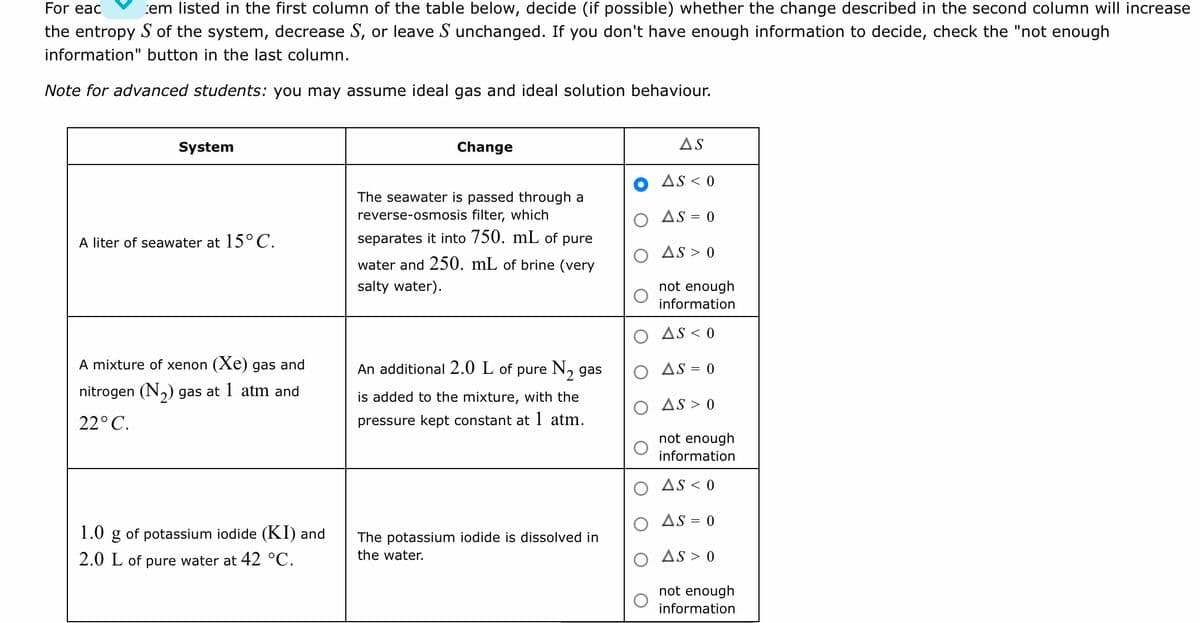For eac em listed in the first column of the table below, decide (if possible) whether the change described in the second column will increase the entropy S of the system, decrease S, or leave S unchanged. If you don't have enough information to decide, check the "not enough information" button in the last column. Note for advanced students: you may assume ideal gas and ideal solution behaviour. System A liter of seawater at 15° C. A mixture of xenon (Xe) gas and nitrogen (N₂) gas at 1 atm and 22°C. 1.0 g of potassium iodide (KI) and 2.0 L of pure water at 42 °C. Change The seawater is passed through a reverse-osmosis filter, which separates it into 750. mL of pure water and 250. mL of brine (very salty water). An additional 2.0 L of pure N₂ gas is added to the mixture, with the pressure kept constant at 1 atm. The potassium iodide is dissolved in the water. O AS<0 O AS=0 Ο ΔS > 0 AS O O AS < 0 O AS=0 O AS>0 not enough information O not enough information O AS<0 O AS=0 Ο ΔS > 0 not enough information
For eac em listed in the first column of the table below, decide (if possible) whether the change described in the second column will increase the entropy S of the system, decrease S, or leave S unchanged. If you don't have enough information to decide, check the "not enough information" button in the last column. Note for advanced students: you may assume ideal gas and ideal solution behaviour. System A liter of seawater at 15° C. A mixture of xenon (Xe) gas and nitrogen (N₂) gas at 1 atm and 22°C. 1.0 g of potassium iodide (KI) and 2.0 L of pure water at 42 °C. Change The seawater is passed through a reverse-osmosis filter, which separates it into 750. mL of pure water and 250. mL of brine (very salty water). An additional 2.0 L of pure N₂ gas is added to the mixture, with the pressure kept constant at 1 atm. The potassium iodide is dissolved in the water. O AS<0 O AS=0 Ο ΔS > 0 AS O O AS < 0 O AS=0 O AS>0 not enough information O not enough information O AS<0 O AS=0 Ο ΔS > 0 not enough information
Chemistry
10th Edition
ISBN:9781305957404
Author:Steven S. Zumdahl, Susan A. Zumdahl, Donald J. DeCoste
Publisher:Steven S. Zumdahl, Susan A. Zumdahl, Donald J. DeCoste
Chapter1: Chemical Foundations
Section: Chapter Questions
Problem 1RQ: Define and explain the differences between the following terms. a. law and theory b. theory and...
Related questions
Question

Transcribed Image Text:For eac
em listed in the first column of the table below, decide (if possible) whether the change described in the second column will increase
the entropy S of the system, decrease S, or leave S unchanged. If you don't have enough information to decide, check the "not enough
information" button in the last column.
Note for advanced students: you may assume ideal gas and ideal solution behaviour.
System
A liter of seawater at 15° C.
A mixture of xenon (Xe) gas and
nitrogen (N₂) gas at 1 atm and
22° C.
1.0 g of potassium iodide (KI) and
2.0 L of pure water at 42 °C.
Change
The seawater is passed through a
reverse-osmosis filter, which
separates it into 750. mL of pure
water and 250. mL of brine (very
salty water).
An additional 2.0 L of pure N₂ gas
is added to the mixture, with the
pressure kept constant at 1 atm.
The potassium iodide is dissolved in
the water.
O
O
AS
AS < 0
AS = 0
AS > 0
not enough
information
AS < 0
AS = 0
AS > 0
not enough
information
AS < 0
AS = 0
AS> 0
not enough
information
Expert Solution
This question has been solved!
Explore an expertly crafted, step-by-step solution for a thorough understanding of key concepts.
Step by step
Solved in 2 steps with 1 images

Knowledge Booster
Learn more about
Need a deep-dive on the concept behind this application? Look no further. Learn more about this topic, chemistry and related others by exploring similar questions and additional content below.Recommended textbooks for you

Chemistry
Chemistry
ISBN:
9781305957404
Author:
Steven S. Zumdahl, Susan A. Zumdahl, Donald J. DeCoste
Publisher:
Cengage Learning

Chemistry
Chemistry
ISBN:
9781259911156
Author:
Raymond Chang Dr., Jason Overby Professor
Publisher:
McGraw-Hill Education

Principles of Instrumental Analysis
Chemistry
ISBN:
9781305577213
Author:
Douglas A. Skoog, F. James Holler, Stanley R. Crouch
Publisher:
Cengage Learning

Chemistry
Chemistry
ISBN:
9781305957404
Author:
Steven S. Zumdahl, Susan A. Zumdahl, Donald J. DeCoste
Publisher:
Cengage Learning

Chemistry
Chemistry
ISBN:
9781259911156
Author:
Raymond Chang Dr., Jason Overby Professor
Publisher:
McGraw-Hill Education

Principles of Instrumental Analysis
Chemistry
ISBN:
9781305577213
Author:
Douglas A. Skoog, F. James Holler, Stanley R. Crouch
Publisher:
Cengage Learning

Organic Chemistry
Chemistry
ISBN:
9780078021558
Author:
Janice Gorzynski Smith Dr.
Publisher:
McGraw-Hill Education

Chemistry: Principles and Reactions
Chemistry
ISBN:
9781305079373
Author:
William L. Masterton, Cecile N. Hurley
Publisher:
Cengage Learning

Elementary Principles of Chemical Processes, Bind…
Chemistry
ISBN:
9781118431221
Author:
Richard M. Felder, Ronald W. Rousseau, Lisa G. Bullard
Publisher:
WILEY